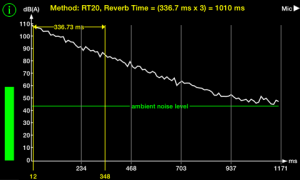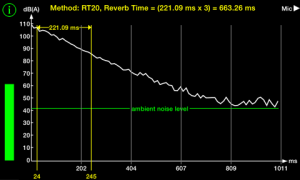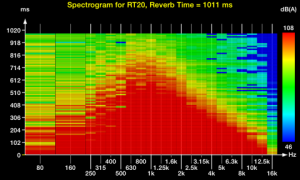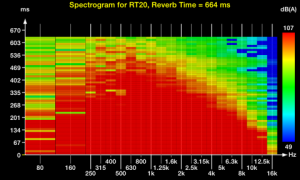This project began with the observation that the Community Room, while an aesthetically pleasing and very functional meeting space, has some challenges with acoustics. The vaulted ceiling and hard surfaces create a very ‘live’ reverberant room which has some benefit for music performance, but makes hearing spoken word more difficult. Several users of the room had complained that the room was noisy at coffee hour, and difficult to hear in during meetings. Since the primary use of the space is for meetings, we decided it would be good to try and mitigate the reverberance of the room and improve it’s acoustical performance with strategically placed sound absorption panels.
Dave Swanson solicited input from an acoustics consultant (Bryan Knisley – North Orbit Acoustics) who helped us to confirm that we could achieve the desired effect with acoustical panels. They also helped us to quantify a goal of reducing the reverb measurement using the RT60 method to something approaching 600ms in order to make the room more conducive to conversation. Dave received a proposal with a basic panel design, materials list, and labor quote. Dave created a detailed schematic for the room for panel placement and sourced the panel materials and we determined we could do the installation ourselves and save the $1000 installation cost.
In order to demonstrate that we were on the right track with improving the acoustics of the room using sound absorption, Dave arranged for a quilt show in the Community Room, the idea being (in addition to enjoying the talents of Bethlehem quilters!) to show a reduction in sound levels with absorption materials in place. The show was held on 3/19/2014 and was a success. Greg Alm ran some sound readings of the overall dB level during coffee hour, and found a significant reduction whilst amongst the quilts. Dave wrote up a report of the event recommending that we move ahead with the panels – read his report here: Comm Rm Acoustics 3 19 14
On Tuesday 4/8/2014, under the leadership of Dave Swanson, members of the ‘Tuesday Crew’ Greg Alm, Larry Johnson, Peter Koontz were enlisted to do the install, with Larry supplying the scaffolding and Dave Johnson helping with scaffolding transport from Larry’s house to the church. Before work began, Dan Cummings and Greg Alm helped with acoustic measurement of the room in order to create a ‘before’ and ‘after’ picture and measure the success of the project.
By all measures, the project was a success! We achieved about a 35% reduction in reverberation in the room after hanging the panels. Here is an example before and after reading of the reverberation characteristics of the room. (The RT60 measurement basically quantifies ‘echo’ by measuring the amount of time in milliseconds that it takes for a noise, like a balloon pop, to disapate to below 60 decibels)
Before: (1010ms) After – (663ms)




Two methods of measurement were used:
We used an iPad app called RevMeter Pro which is a very easy-to-use tool to arrive an at RT60 measurement. Read more about Reverberation and RT60 by clicking these links. Also some history on RT60 here
We also used an anecdotal sampling of sound pressure level during a typical Sunday morning coffee hour using an iPad app called Decibel Meter Pro Greg measured levels of sound between 95- 100 dB at peak and 90 dB average before the quilt show and a reduction of about 10% during the quilt show We are looking forward to measuring now after panel installation.






























This is exactly the kind of report I like to see but that is probably because I was a part of it. Perhaps it is a little too technical for the membership. Good for the archives, though.
I loved this article! I appreciate the thought that went into this and that Dave was willing to do his quilt experiment before investing in the panels. Thanks to the Tuesday crew for all you do for our church!